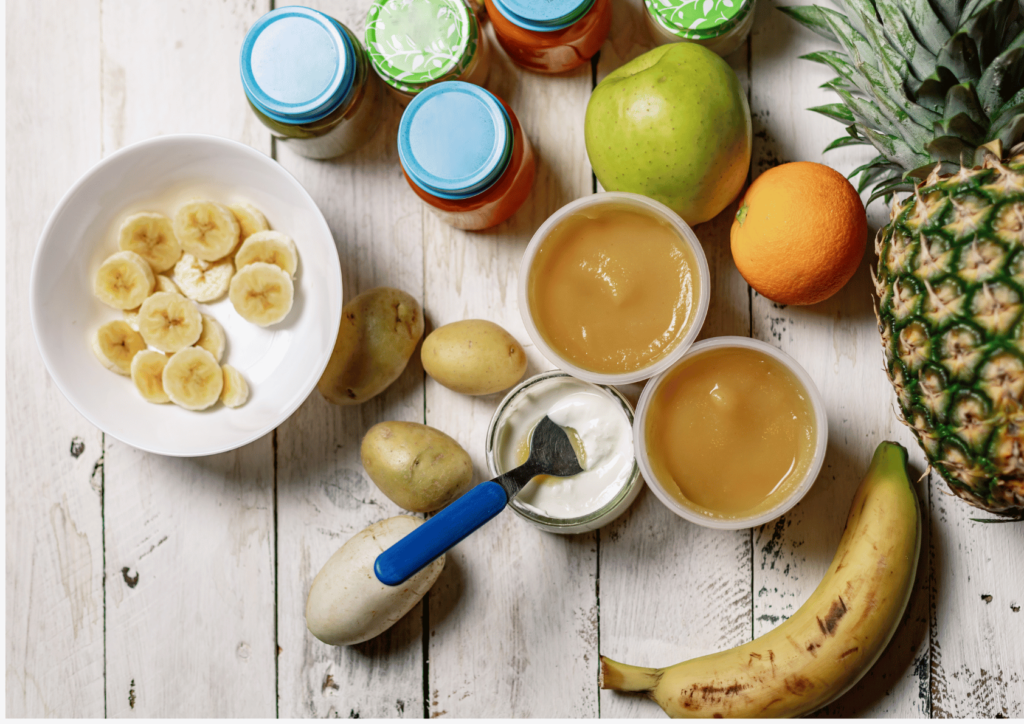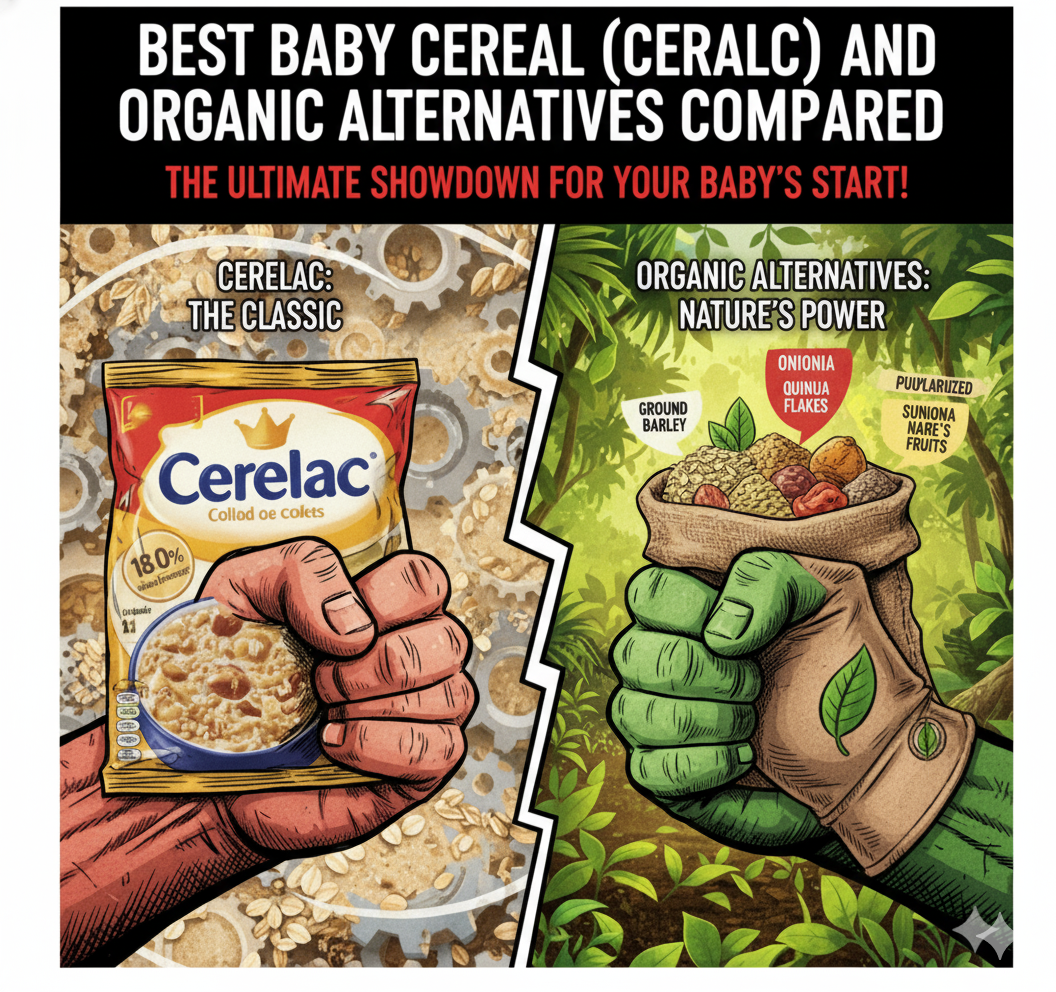
6 Month Baby Food Guide : Chart, Quantity & Best First Foods
Topic
6 Month Baby Food Guide : Chart, Quantity & Best First Foods
May start as early as
At 6 Month
─────────
May end around
12 Months
6 Month Baby Food Guide: What, How Much & When – Starting solids is one of the most exciting milestones in your baby’s life. Parents often ask: what food should be given to a 6 month baby? how much quantity? what chart to follow? This complete six month baby food guide combines trusted recommendations with easy Indian diet examples. You’ll find a six month baby food chart, portion quantities, best foods for brain and weight development, and links to detailed guides.
Whether you are preparing banana puree, ragi porridge, or khichdi, the goal is simple: keep food safe, iron-rich, and baby-friendly while continuing breastmilk or formula as the primary nutrition.
What all we will cover in the blog?
- When to Start 6 Month Baby Food
- 6 Month Baby Food Chart (Sample Indian Plan)
- How Much Quantity of Food for 6 Month Baby
- Weight Gain Foods for 6 Month Baby
- FAQs
When to Start 6 Month Baby Food
- Global health bodies like WHO and AAP recommend starting solids at around 6 months.
- Signs of readiness:
- Baby can sit with support.
- Baby opens mouth for spoon.
- Baby has lost tongue-thrust reflex.
- Baby has doubled birth weight.
👉 For a detailed checklist, read our guide: How to Start Food for 6 Months Baby (Step-Wise Indian Guide).

Uptodd Cereal is Live Now !!
What Foods Can a 6 Month Baby Eat?
Your baby is now ready to try first solids. The best six month baby foods are single-ingredient, soft, and easy to digest.
Examples of first foods for 6 month baby:
- Mashed banana or avocado
- Steamed and mashed apple, pear, or carrot
- Rice cereal, ragi porridge, dal water
- Soft cooked potato or sweet potato
Indian diet options:
- Ragi (finger millet) porridge for iron
- Moong dal khichdi for protein + carbs
- Banana puree for calories and weight gain
- Apple or carrot puree for vitamins
❌ Avoid honey, cow’s milk, sugar, salt, and nuts in whole form.

6 Month Baby Food Chart (Sample Indian Plan)
Here’s a simple chart to guide you.
| Time | Food (Quantity) | Notes |
|---|---|---|
| Morning | 2–3 tsp mashed banana | Energy + potassium |
| Mid-morning | Breastfeed/formula | Still main nutrition |
| Lunch | 2–3 tbsp rice + dal/ragi | Iron, protein, satiety |
| Evening | 2–3 tbsp steamed apple/carrot | Vitamin C + fiber |
| Night | Breastfeed/formula | Comfort + immunity boost |
👉 Explore more ideas in: Detailed 6 Month baby Food Chart.
How Much Quantity of Food for 6 Month Baby
- Begin with 2–3 teaspoons once a day.
- Progress to 2–3 tablespoons twice a day, then three times/day.
- Total intake: ~90–120 ml of solids daily.
- Always follow your baby’s hunger cues.
👉 See detailed schedules and ml/tbsp breakdown in our dedicated article : How Much Quantity of Food for 6 Month Baby.
Brain Development Foods at 6 Months
Brain growth is rapid during the first two years. The right six month baby food can support this.
Key nutrients:
- Iron (ragi, moong dal, spinach puree)
- Healthy fats (ghee, avocado, nut powders if safe)
- Omega-3s (flaxseed powder, small fish after pediatrician approval)
Sample pairings:
- Ragi porridge + mashed apple (iron + vitamin C)
- Moong dal + a drop of ghee
- Banana with nut powder (if no allergy risk)
👉 Dive deeper: Brain Food for Babies at 6 Months
Complete guidance on baby brain development food age-wise
Weight Gain Foods for 6 Month Baby
Some babies need extra calorie-dense foods. The best six month baby foods for weight gain are:
- Banana
- Sweet potato mash
- Dal khichdi with a drop of ghee
- Avocado puree
- Rice cereal fortified with iron
⚠️ Avoid overfeeding — weight gain should be steady, not sudden.
👉 Get detailed guidance : Weight Gain Foods for 6 Month Baby
Tips for Feeding 6 Month Baby Safely
- Introduce only one new food at a time.
- Maintain a 3-day gap to observe allergies.
- Always ensure food is soft and mashed.
- Continue breastfeeding or formula – solids are complementary.
FAQs
1. What is the best first food for 6 month baby?
Mashed banana, ragi porridge, or rice cereal are common first foods.
2. How many times should a 6 month old eat solids?
Start once daily, increase gradually to 2–3 times per day.
3. How much food should a six month baby eat per meal?
2–3 tbsp per meal, about 90–120 ml/day.
4. Which food is good for weight gain at 6 months?
Banana, sweet potato, moong dal khichdi, avocado.
5. Which food helps in brain development?
Iron-rich foods paired with vitamin C, plus healthy fats.
Visit here chinese gender predictor & know more about the same
Conclusion
This six month baby food guide gives you everything you need: safe first foods, a daily chart, quantity guidelines, and ideas for brain and weight support. Remember: every baby is different. Go slow, follow cues, and use this hub as a foundation.
For deeper dives:
Weight Gain Foods for 6 Month Baby
How to Start Food for 6 Months Baby
How Much Quantity of Food for 6 Month Baby.
Brain Food for Babies at 6 Months
Detailed 6 Month baby Food Chart
Weight Gain Food for 6-12 Month baby
Tiny tummies, big needs! See the ultimate 0-3 baby food chart and must-have nutrients now!
Do you want your baby to gain weight fast Click for the complete guide
Unlock their potential: What to buy your baby from 0 to 3 years.
Research & Resources
- World Health Organization (WHO) – Infant and young child feeding: guiding principles for complementary feeding👉 https://www.who.int/news-room/fact-sheets/detail/infant-and-young-child-feeding
- American Academy of Pediatrics (AAP) – Starting Solid Foods👉 https://www.healthychildren.org/English/ages-stages/baby/feeding-nutrition/Pages/Switching-To-Solid-Foods.aspx
- NHS (UK National Health Service) – What to feed your baby at 6 months👉 https://www.nhs.uk/start-for-life/weaning/what-to-feed-your-baby/
- CDC (Centers for Disease Control and Prevention) – When, What, and How to Introduce Solid Foods👉 https://www.cdc.gov/infant-toddler-nutrition/foods-and-drinks/when-what-and-how-to-introduce-solid-foods.html






